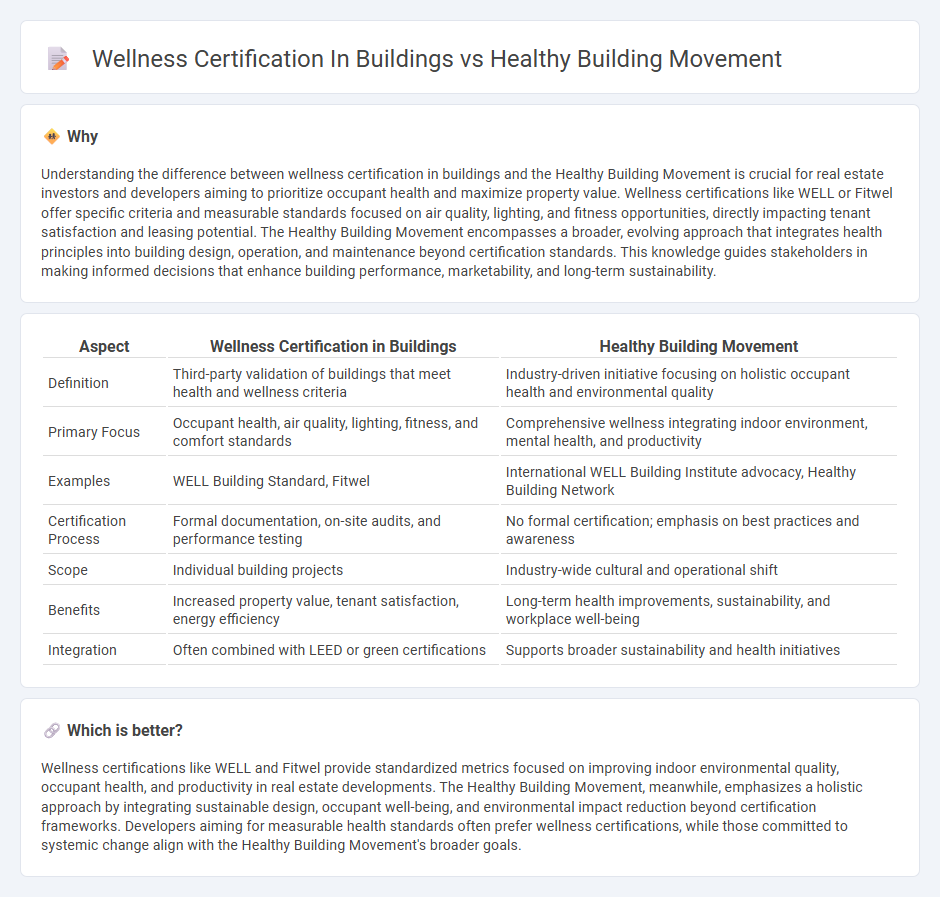
Wellness certification in buildings, such as WELL and Fitwel, focuses on individual health by assessing air quality, lighting, and occupant comfort to enhance physical and mental well-being. The Healthy Building Movement expands this scope by integrating sustainable design, energy efficiency, and environmental impact alongside occupant health. Discover how these approaches transform real estate development and property value.
Why it is important
Understanding the difference between wellness certification in buildings and the Healthy Building Movement is crucial for real estate investors and developers aiming to prioritize occupant health and maximize property value. Wellness certifications like WELL or Fitwel offer specific criteria and measurable standards focused on air quality, lighting, and fitness opportunities, directly impacting tenant satisfaction and leasing potential. The Healthy Building Movement encompasses a broader, evolving approach that integrates health principles into building design, operation, and maintenance beyond certification standards. This knowledge guides stakeholders in making informed decisions that enhance building performance, marketability, and long-term sustainability.
Comparison Table
| Aspect | Wellness Certification in Buildings | Healthy Building Movement |
|---|---|---|
| Definition | Third-party validation of buildings that meet health and wellness criteria | Industry-driven initiative focusing on holistic occupant health and environmental quality |
| Primary Focus | Occupant health, air quality, lighting, fitness, and comfort standards | Comprehensive wellness integrating indoor environment, mental health, and productivity |
| Examples | WELL Building Standard, Fitwel | International WELL Building Institute advocacy, Healthy Building Network |
| Certification Process | Formal documentation, on-site audits, and performance testing | No formal certification; emphasis on best practices and awareness |
| Scope | Individual building projects | Industry-wide cultural and operational shift |
| Benefits | Increased property value, tenant satisfaction, energy efficiency | Long-term health improvements, sustainability, and workplace well-being |
| Integration | Often combined with LEED or green certifications | Supports broader sustainability and health initiatives |
Which is better?
Wellness certifications like WELL and Fitwel provide standardized metrics focused on improving indoor environmental quality, occupant health, and productivity in real estate developments. The Healthy Building Movement, meanwhile, emphasizes a holistic approach by integrating sustainable design, occupant well-being, and environmental impact reduction beyond certification frameworks. Developers aiming for measurable health standards often prefer wellness certifications, while those committed to systemic change align with the Healthy Building Movement's broader goals.
Connection
Wellness certification in buildings, such as WELL and Fitwel, directly supports the Healthy Building Movement by promoting design strategies that enhance occupant health and well-being through improved air quality, natural lighting, and ergonomic spaces. These certifications provide measurable standards that align with the Healthy Building Movement's goal of creating environments that reduce stress, prevent illness, and increase productivity. Integrating wellness certification into real estate development drives demand for healthier, sustainable buildings, influencing market value and tenant satisfaction.
Key Terms
Indoor Air Quality
The Healthy Building Movement emphasizes creating indoor environments that promote occupant well-being by addressing multiple factors, with indoor air quality (IAQ) as a critical component for reducing pollutants and allergens. Wellness certifications, such as WELL and Fitwel, incorporate IAQ standards by evaluating ventilation, filtration, and pollutant control to ensure healthier breathing conditions within buildings. Explore the latest strategies and standards shaping the future of indoor air quality in building wellness to enhance occupant health.
WELL Building Standard
The Healthy Building Movement emphasizes creating environments that promote occupant health and productivity through improved air quality, natural lighting, and materials safety, while wellness certifications like the WELL Building Standard provide a comprehensive framework that integrates evidence-based design strategies focusing on physical, mental, and social well-being. The WELL Building Standard evaluates buildings across seven core concepts: air, water, nourishment, light, fitness, comfort, and mind, driving measurable outcomes that align with public health goals. Explore the detailed criteria and benefits of the WELL Building Standard to enhance your building's wellness impact and occupant satisfaction.
Biophilic Design
The Healthy Building Movement emphasizes creating indoor environments that support occupant health through improved air quality, natural light, and materials with low chemical emissions, while wellness certifications like WELL or Fitwel integrate these principles with explicit biophilic design elements such as natural vegetation, water features, and daylight access to enhance mental well-being. Biophilic design in buildings fosters a connection to nature, promoting stress reduction and cognitive benefits, which are increasingly prioritized in both movements to optimize occupant productivity and satisfaction. Explore how biophilic strategies distinguish healthy buildings and wellness-certified spaces to create impactful, nature-infused interiors.
Source and External Links
Healthy Building Movement - What is it? - This page discusses the Healthy Building Movement, which aims to promote green living through sustainable buildings, focusing on optimal indoor conditions for health and productivity.
About the Healthy Buildings Program - The Healthy Buildings Program at Harvard aims to improve lives by advancing human health within the built environment through research and collaboration.
The Healthy Building Movement: A focus on occupants - This article highlights the shift towards prioritizing the well-being of building occupants, aligning with environmental sustainability and social equity.
 dowidth.com
dowidth.com